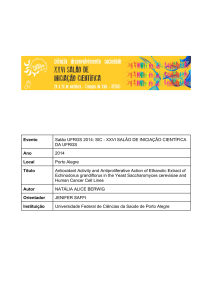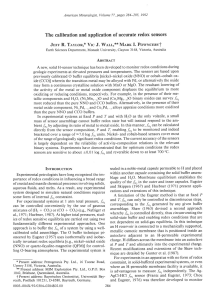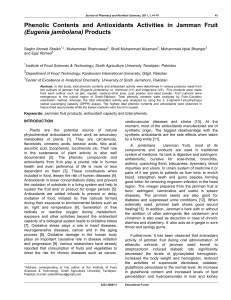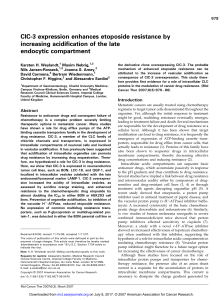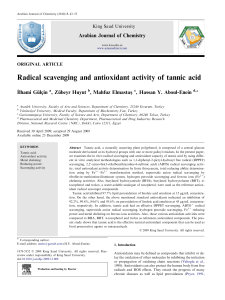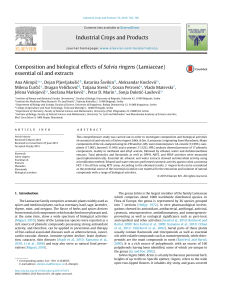UNIVERSIDADE FEDERAL DO RIO GRANDE DO SUL FACULDADE DE FARMÁCIA
publicité
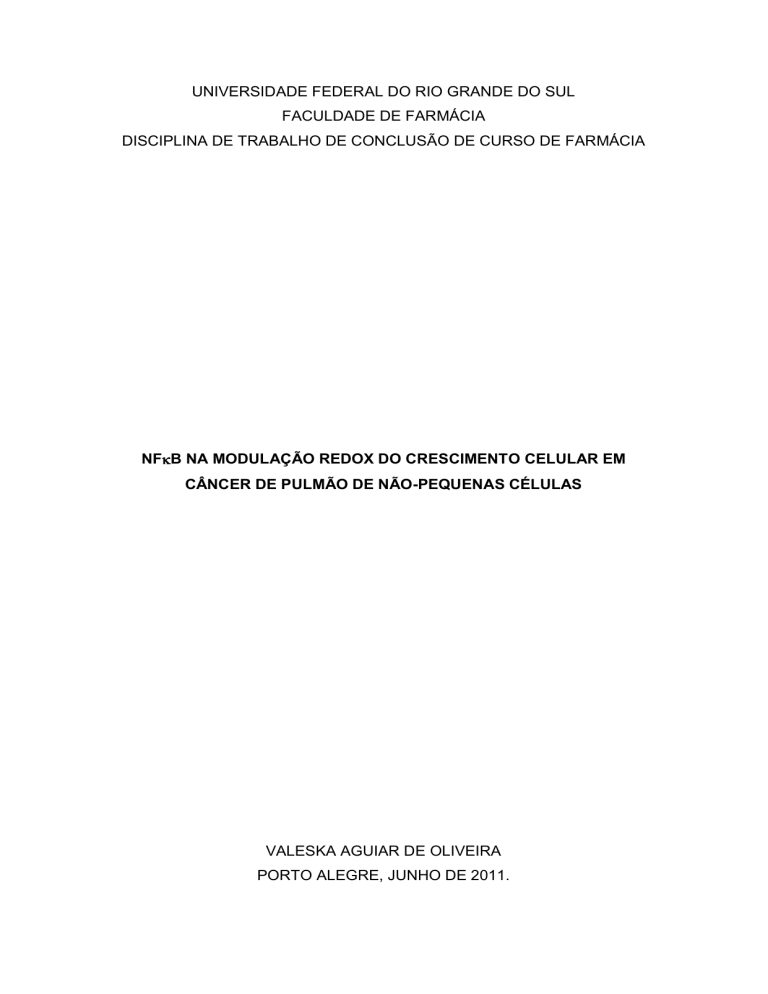
UNIVERSIDADE FEDERAL DO RIO GRANDE DO SUL FACULDADE DE FARMÁCIA DISCIPLINA DE TRABALHO DE CONCLUSÃO DE CURSO DE FARMÁCIA NFB NA MODULAÇÃO REDOX DO CRESCIMENTO CELULAR EM CÂNCER DE PULMÃO DE NÃO-PEQUENAS CÉLULAS VALESKA AGUIAR DE OLIVEIRA PORTO ALEGRE, JUNHO DE 2011. 1 UNIVERSIDADE FEDERAL DO RIO GRANDE DO SUL FACULDADE DE FARMÁCIA DISCIPLINA DE TRABALHO DE CONCLUSÃO DE CURSO DE FARMÁCIA NFB NA MODULAÇÃO REDOX DO CRESCIMENTO CELULAR EM CÂNCER DE PULMÃO DE NÃO-PEQUENAS CÉLULAS Autora: Valeska Aguiar de Oliveira Orientador: Prof. Dr. Fábio Klamt Co-orientador: Msc. Leonardo Lisbôa da Motta TRABALHO DE CONCLUSÃO DE CURSO - FARMÁCIA PORTO ALEGRE, JUNHO DE 2011 2 Este trabalho foi realizado no Laboratório 24, Departamento de Bioquímica Prof. Tuiskon Dick do Instituto de Ciências Básicas da Saúde, Universidade Federal do Rio Grande do Sul. Foi financiado pelo Conselho Nacional e Tecnológico (CNPq). 3 AGRADECIMENTOS Ao professor Fábio Klamt, um grande orientador, pela oportunidade que me ofereceu para realizar esse trabalho, pela amizade, dedicação e, principalmente, pelo exemplo de caráter, pesquisador, professor e amigo em quaisquer que sejam as circunstâncias. Ao Leonardo Motta, co-orientador, grande parceiro que muito me ensinou. Agradeço pela companhia nos intermináveis dias de experimento e por aturar meus “pitis”. “Bem ou mal”, tua ajuda foi importantíssima para a conclusão desse trabalho. À Fernanda Lopes, grande amiga que desde o meu primeiro momento no laboratório SEMPRE me ajudou, me “guiou” e principalmente me “salvou”. Fê te agradeço muito por toda a parceria, e por tudo que me ensinou, e por tornar todo trabalho uma diversão. Tu és “MARA”! Pode contar sempre comigo. À Giovana Londero e à Liana Marengo, por todos os “galhos quebrados”. Aos colegas do Lab 24, por tornarem tudo mais fácil, por aturarem meu mau-humor matinal, minhas irritações e tornarem meus dias MUITO mais alegres. Certamente a companhia diária de vocês é um dos principais estímulos pra trabalhar. Ao povo da ATF2011/1, grandes colegas, dos quais nunca esquecerei e certamente sentirei enormes saudades. Aos meus pais Junior e Lisiane, por todo o sacrifício que sempre fizeram para que hoje eu estivesse aqui. Por todas as oportunidades que me deram, por toda a confiança que em mim depositaram, por todo amor e dedicação. Aos meus avós Otamiro e Carminha, meus segundos pais. Agradeço por todo amor e educação que sempre me deram. Por me mostrarem a importância de se ter disciplina e bom caráter, e principalmente, por toda a dedicação na minha criação. Também quero agradecer aos meus avós José e Elza, que me acolheram e ampararam em uma nova etapa da minha vida. À toda minha família que sempre me apoiou, agradeço muito por todo amor, preocupação e compreensão quando, muitas vezes, estive ausente. Com certeza, sem vocês eu nada seria. 4 Este trabalho foi elaborado na forma de artigo científico segundo as normas do periódico “Molecular Carcinogenesis” apresentadas em anexo. 5 TITLE PAGE Title: NFB in the redox-modulation of cell growth in nonsmall cell lung cancer Authors: Valeska A. Oliveira, Leonardo L. Motta, Fernanda M. Lopes, Christiane Salbego, Fabio Klamt Department of Biochemistry, ICBS/UFRGS, Porto Alegre/RS, Brazil; *Corresponding author: Prof. Fábio Klamt, Ph.D. Lab. 24, Departamento de Bioquímica, ICBS/ Universidade Federal do Rio Grande do Sul (UFRGS), Rua Ramiro Barcelos 2600, Porto Alegre/RS, 90035-003, Brasil. Phone: +55 51 3308-5555; Fax: +55 51 3308-5535; e-mail: [email protected] 6 Running title: NFB in redox-modulation of lung cancer growth Grant support: This work was supported by the Brazilians funds MCT/CNPq Universal (476114/2008-0), FINEP/IBN-Net (01060842-00), PRONEX/FAPERGS (1000274) and MCT/CNPq INCT-TM (573671/2008-7). F.K. received a fellowship from MCT/CNPq (303613/2008-4). Abreviations: H2O2 – hydrogen peroxide; CAT- catalase; NSCLC- non-small cell lung cancer; NFB- nuclear factor kappa B; AdC – adenocarcinoma; LCC - large cell carcinoma; RS - reactive species; IL-1- interleukin-1; TNF - tumour-necrosis factor; SRB - sulforhodamine B; TRAP - radical-trapping antioxidant potential; SH- sulfhydryl groups; GST - glutathione S-transferase TBARS - tiobarbituric acid reactive species Keywords: A549, catalase, NSCLC, tumor aggressiveness 7 ABSTRACT Lung cancer is the most lethal malignant disease worldwide with limited efficacy of current therapeutics and dismal prognostic. Approximately 80% of the cases are non-small cell lung cancer (NSCLC). NFB is a major transcription factor associated with tumor progression that responds to stressful stimuli, such as oxidative stress, influencing cell survival and chemoresistance. Since NSCLC aggressiveness is associated with higher intracellular oxidative stress, this study evaluated the involvement of NFB in the redox modulation of tumor aggressiveness in the human NSCLC cell line A549. Treatment with the antioxidant enzyme catalase (CAT) (1000 U/mL) for 96h inhibited cell proliferation and when the enzyme was withdraw of the enzyme restored cell proliferation rates. In addition, catalase treatment decreased intracellular thiol levels (SH) and non-enzymatic antioxidant potential (TRAP). This redox modulation could be explained by the antioxidant contribution provided by high dose of exogenous CAT and was also reverted when the enzyme was withdraw. In agreement with the decreases in antioxidant defenses, the activation of the redox-sensitive transcription factor NFB was decreased in catalase-treated cells as assessed by Western blotting for the nuclear content of the NFB member p65. Taken together, data presented here suggest that decreases in the pro-oxidant status of lung cancer cells with catalase treatment can inhibit cell proliferation and activation of tumor-associated signaling pathways, providing a new therapeutic strategy for NSCLC therapy. 8 INTRODUCTION Lung cancer remains the most common and lethal cancer-related pathology [1], with approximately 1.1 million deaths annually worldwide [2]. There are two main types of lung cancer with epithelial origin: small cell lung cancer (SCLC) and non-small cell lung cancer (NSCLC) [2]. The latter comprises more than 80% of all cases of lung cancer [3] and is divided in three major histological subtypes: adenocarcinoma (AdC), large cell carcinoma (LCC) and squamous cell carcinoma [4]. Despite progress in molecular research, the therapeutic armamentarium remains poor [5] and unable to improve NSCLC patients outcome, which have a 5 year survival of only 15% [1]. All steps involved in malignant transformation are influenced by the redox metabolism [6,7] and previous studies demonstrated that NSCLC aggressiveness is associated with elevated intracellular oxidative stress. On the other hand, it was already demonstrated that exogenous treatment with the antioxidant enzyme catalase (CAT) (Motta et. al, unpublished data) and CAT overexpression attenuated tumor aggressiveness [8]. Free radicals and other reactive species (RS) are generated physiologically in every cells and its homeostasis is maintained by antioxidant systems [9]. Despite their harmful effects, RS can also enhance cellular proliferation, migration, differentiation, and survival [8,10]. Recently RS have been described as mediators of oncogenic phenotype activating transcription factors such as NFB and AP-1 [6]. NFB is a major transcription factor that modulates gene expression in response to growth factors, proinflammatory agents such as interleukin-1 (IL-1), tumor-necrosis factor (TNF), oxidants and cytotoxic drugs. [11-14]. The NFB family contains five members, which form homo and heterodimers and exist in the cytoplasm in an inactive state bound to inhibitory protein IB. The most common form of NFB is the p65/p50 heterodimer that, when activated, translocates to the nucleus, where if activates transcription of target genes [15]. Substantial studies indicate that NFκB regulates oncogenesis and tumor progression since NFB can induce cell proliferation, cell-cycle progression, angiogenesis, metastasis by enhancing the transcription of anti-apoptotic and 9 antioxidant genes including Bcl-xL c-FLIP, SOD2, glutathione S-transferase, and ferritin heavy chain [12,14,16-18]. This way, the present study aimed to investigate if NFB could be involved in the cytostatic effect of CAT treatment in NSCLC. For this purpose, the human NSCLC cell line A549 was treated with exogenous CAT, and the proliferative behavior, intracellular redox status and p65 nuclear and cytosolic immunocontent were evaluated. It was found that CAT inhibits cell proliferation, reduces intracellular antioxidant capacity and decreases p65 nuclear immunocontent. Thus, redox modulation of NSCLC aggressiveness might rely on NFB activation, and NFB activation/inhibition could provide a future target to adjuvant therapeutics interventions. MATHERIAL AND METHODS Cell Lines and Cell Culture Exponential growing human non-small cell lung cancer cell line A549, obtained from NCI-Frederick Cancer DCTD cell line repository, was maintained in RPMI 1640 medium supplemented with 10% heat-inactivated fetal bovine serum (FBS), 2 mM L-glutamine, 1 mg/L of amphotericine B and 50 mg/Lof garamicin, in a humidified atmosphere of 5% of CO 2 in air at 37°C. CAT Treatment and Growth Inhibition Assays The intracellular levels of H2O2 can be reduced with exogenous addition of CAT (E.C. 1.11.1.6), once H2O2 diffuses through membranes [19].Cells (2x104) were seeded in a 12 well plate and, after adherence, their redox state was modulated by addition of purified active or heat-inactivated CAT (1,000 U/mL). The cell number was evaluated each 24h for 120h of treatment using Neubauer chamber cell counting and Sulforhodamine B (SRB) assay [20]. In SRB assay, cells were fixed with cold 10% TCA for 1h at 4°C, washed with 10 distilled water and dried at room temperature. Then, cells were stained with 0.2% SRB (w/v) in 1% acetic acid (v/v) at room temperature for 20 min followed by five times washing with 1% acetic acid, before air-drying. Bound dye was solubilized with 10 mM Tris-base solution (pH 10.5) and plates were left on a plate shaker for 10 min. Absorbance was measured at 490 nm. Data is expressed as “cell number” with a standard curve (cell number X SRB abs). To revert CAT effects in A549 cells, the enzyme was washed out after 48h of treatment. Samples Preparation for Redox Profile Analysis Cells (2 x 104) were cultivated in 12 well plates, washed with PBS and frozen-and-thawed in 10 mM PBS three times prior to harvesting and then centrifuged (400g /6 min). The supernatant protein concentration was determined by Lowry’s [21] for data normalization. Redox Parameters The total antioxidant capacity of cells was evaluated by total radicaltrapping antioxidant potential (TRAP) assay. This assay is based on luminolchemoluminescence measurement induced by ABAP (2,2'-Azo-bis(2- amidinopropane) in glycine buffer (pH 8.6) [22]. After system stabilization, sample was added (20 μg of protein) and the chemoluminescence decreases proportionally to the amount of non-enzymatic antioxidants monitored (Wallace 1450 MicroBetaTriLux Liquid Scintillation Counter & Luminometer, Perkin Elmer). A time per chemoluminescence curve was obtained and the relative “area under the curve” (AUC) in the recovery phase used to analysis [22]. Sulfhydryl groups (-SH) level was measured as an indicative of the intracellular redox state, as previously described [23]. Samples (35 μg) were diluted in PBS 10 mM and buffer (10 mM boric acid, 0.2 mM EDTA pH 8.5). DTNB 10 mM (5, 11 5’-dithionitrobis 2-nitrobenzoic acid) was added and, after 60 min, it was read at 412 nm. Results are expressed as nmol SH/mg protein. Cytoplasmic and Nuclear fractions For extraction of cytoplasmic and nuclear fractions, cells were scraped, harvested and collected by centrifugation (4,000 rpm/ 4 min). The cells were then lysed by resuspension in hypotonic buffer (10mM HEPES (pH 7.9), 1.5 mM MgCl2, 1 mM EDTA, 10 mM KCl, 1 mM phenylmethylsulfonyl fluoride, proteases inhibitor cocktail (Roche®), 1 mM sodium orthovanadate, 5 mM sodium fluoride) and incubated on ice for 15 min. After, 10% IGEPAL ® was added and cells were disrupted by vortexing (every 15 s for 5 min). The resulting suspension was centrifuged at (14,000 rpm/30 seg), and the supernatant (cytoplasmic extract) was separated and stored at -80°C. The nuclear pellet was washed with cytoplasmic extraction buffer and then resuspended in high salt buffer consisting 20 mM HEPES (pH 7.9), 400 mM NaCl, 1.5 mM MgCl2, 0.25 mM EDTA, 0.5 mM phenylmethylsulfonyl fluoride, 1 mM dithiothreitol, 1 mM sodium orthovanadate, proteases inhibitor cocktail (Roche ®), and 25% glycerol and incubated for 40 min in ice and vortexed for 15 s every 5 min to releasing soluble proteins from the nuclei. After, the nuclear fraction was centrifuged (12,000g/ 10 min) and supernatant containing soluble nuclear proteins was stored at -80°C until experiments. The protein concentration was determined by Bradford assay [24]. Western Blot Cytoplasmic and nuclear proteins extracts were separated by sodium dodecyl sulfate-polyacrylamide gel eletrophoresis (SDS-PAGE) and then transferred onto nitrocelulose membrane. Thereafter, nonspecific binding was blocked with 5% of BSA in TBS-T (50 mM Tris, 150 mM NaCl, 0.05% Tween 20 - pH 7.6) for 1h at room temperature. Membranes were than incubated overnight at 4°C with primary antibodies anti-p65 (1:1000) from Santa Cruz® or 12 anti--actin (1:1000) from Cell Signaling®. After washing in TBS-T, blots were incubated with horseradish peroxidase-linked anti-immunoglobulin G (IgG) secondary antibodies for 2h at room temperature. Bands were visualized with Super Signal West Pico Chemislumiscense Substrate from PIERCE ® (Rockford, II,USA) and quantified using Image-J® software. Statistical analysis Data are expressed as means ± S.E.M. (standard error of mean) of at least 3 independent experiments in triplicate with significance level considered p < 0.05. Statistical analysis and graphs were obtained with GraphPad Software Inc., San Diego, CA, USA version 5.0. RESULTS NSCLC Growth Inhibition by CAT Exogenous addition of catalase caused inhibition of cellular proliferation in human NSCLC A549 cells (Fig. 1). This effect was observed in 24h of treatment and maintained over 120h of treatment. This growth inhibition was related to a cytostatic, not cytotoxic, effect of intracellular H2O2 consumption, since CAT washout readily restored cellular proliferative rate similar to control A549 cells (Fig.1). Based on the abovementioned data, we used 48 and 96h of treatment for the following experiments. CAT influence in NSCLC intracellular redox state CAT-treated cells presented lower antioxidant potential and thiol levels when compared to untreated cells (Fig. 2). Notably, the decrease in antioxidant 13 potential was time dependent for both groups, while thiol levels were not. CAT washout was able to restore both thiol and antioxidant potential levels. NFB Activation Time course experiments showed that CAT treatment for 48h caused a decrease in tumor cell proliferation, decreased intracellular antioxidant capacity and thiol levels. When we evaluated NFB activation status (p65 subcellular compartmentalization/distribution), we found decreases in the nuclear immunocontent of the NFB subunit p65, suggesting a decreased in NFB activation in CAT-treated A549 cells (Fig. 3). DISCUSSION Among malignancies, lung cancer ranks as one of the most common and lethal. Although chemotherapy presents efficacy for some patients with lung cancer, effective therapeutic options for advanced stages of the disease remain limited and cure rates are low [25]. Extensive evidence has shown that cancer cells have an imbalance in redox parameters compared to normal cells, which are related to carcinogenesis and tumor progression [26]. CAT is one of the most effective antioxidant enzymes and is very efficiently to promote the conversion of hydrogen peroxide to water and molecular oxygen [6]. Controversial results have been reported regarding the involvement of H2O2 in cell proliferation [8]. Thus, we treated A549 cells with CAT and, once the H2O2-scavenger caused inhibition of cellular proliferation, H2O2 was confirmed as a necessary mediator of A549 proliferation. CAT washout readily restored cellular proliferative rate compared to control cells. Therefore, this was related to a cytostatic, not cytotoxic effect of intracellular H2O2 consumption. The difference in cellular proliferation was statistically significant at 48h and 96h of treatment. Thus, we analyzed the intracellular thiol levels and antioxidant potential in these incubation times to address potential relationship between cellular proliferative rates with intracellular redox 14 state. Once CAT treatment was effective in inhibit cellular proliferation, we aimed to determine if this cytostatic effect was related to changes in intracellular antioxidant defenses. Our results demonstrated that CAT treatment significantly decreased endogenous antioxidant potential. Since H2O2 diffuses through membranes [19], the addition of CAT may be generating a gradient of H2O2 out of the cell. Our data suggest that in response to a reduction in intracellular H2O2 concentration, cells decreased their endogenous production of antioxidant defense. Here, catalase washout also restores the redox state. This could explain the cytostatic effect of CAT, once cellular proliferation can be influenced by alterations in intracellular redox environment through modulation of cell survival signals mediated by redoxsensitive transcription factors [6]. Reactive species are predominantly known for causing cell damage. However cumulative information has related increases in basal levels of RS in cancer cells with tumor progression [8], since RS play a major physiological role in the control of redox-sensitive signaling pathways as NFB. However, the mechanism for activation of NFB by reactive species is not yet clear [6]. We observed a decrease in nuclear immunocontent of the NFB subunit p65 in CAT-treated cells. This reduction in NFB activation status in CAT-treated cells could be related to the global decrease in antioxidant capacity found in this study, since the expression of several antioxidant genes are regulated by this transcription factor. In this way, the evaluation of Bcl-xL, SOD2 and GST immunocontent, and specifically the levels of some oxidative stress markers (e.g.: TBARS, carbonyl groups), in CAT-treated cells could confirm this hypothesis. Therefore, as important as the demonstration that CAT treatment was effective in inhibit cellular proliferation and CAT washout restored the proliferation rates, this protocol can be used as a model to assess the role of RS in chemotherapy efficacy, analyzing whether pre-treatment or co-treatment of CAT with well known cytotoxic drugs (e.g.:cisplatin, carboplatin, VP-16, vimblastine, taxol,…) is able to increase the effectiveness of chemotherapy. Also, this redox modulation of NSCLC aggressiveness might rely on NFB activation. Thus, understanding the relationship between the activity of NFB and the intracellular redox environment can provide us potential targets 15 for future research and further development of new therapies based on redox modulation of cell signaling pathways. Ongoing studies in our laboratory are evaluating these hypotheses. . 16 REFERENCES 1. Jemal A, Siegel R, Xu J, Ward E. Cancer statistics, 2010. CA Cancer J Clin 2010;60(5):277-300. 2. Mountzios G, Dimopoulos MA, Soria JC, Sanoudou D, Papadimitriou CA. Histopathologic and genetic alterations as predictors of response to treatment and survival in lung cancer: a review of published data. Crit Rev Oncol Hematol 2010;75(2):94-109. 3. Sher T, Dy GK, Adjei AA. Small cell lung cancer. Mayo Clin Proc 2008;83(3):355-367. 4. Beadsmoore CJ, Screaton NJ. Classification, staging and prognosis of lung cancer. Eur J Radiol 2003;45(1):8-17. 5. Subramanian J, Govindan R. Lung cancer in never smokers: a review. J Clin Oncol 2007;25(5):561-570. 6. Valko M, Rhodes CJ, Moncol J, Izakovic M, Mazur M. Free radicals, metals and antioxidants in oxidative stress-induced cancer. Chem Biol Interact 2006;160(1):1-40. 7. Visconti R, Grieco D. New insights on oxidative stress in cancer. Curr Opin Drug Discov Devel 2009;12(2):240-245. 8. Policastro L, Molinari B, Larcher F et al. Imbalance of antioxidant enzymes in tumor cells and inhibition of proliferation and malignant features by scavenging hydrogen peroxide. Mol Carcinog 2004;39(2):103-113. 9. Halliwell B. Reactive species and antioxidants. Redox biology is a fundamental theme of aerobic life. Plant Physiol 2006;141(2):312-322. 10. Storz P. Reactive oxygen species in tumor progression. Front Biosci 2005;10:1881-1896. 11. Sakon S, Xue X, Takekawa M et al. NF-kappaB inhibits TNF-induced accumulation of ROS that mediate prolonged MAPK activation and necrotic cell death. EMBO J 2003;22(15):3898-3909. 12. Nakanishi C, Toi M. Nuclear factor-kappaB inhibitors as sensitizers to anticancer drugs. Nat Rev Cancer 2005;5(4):297-309. 17 13. Bowie A, O'Neill LA. Oxidative stress and nuclear factor-kappaB activation: a reassessment of the evidence in the light of recent discoveries. Biochem Pharmacol 2000;59(1):13-23. 14. Zanotto-Filho A, Delgado-Canedo A, Schroder R, Becker M, Klamt F, Moreira JC. The pharmacological NFkappaB inhibitors BAY117082 and MG132 induce cell arrest and apoptosis in leukemia cells through ROSmitochondria pathway activation. Cancer Lett 2010;288(2):192-203. 15. Perkins ND. Integrating cell-signalling pathways with NF-kappaB and IKK function. Nat Rev Mol Cell Biol 2007;8(1):49-62. 16. Zanotto-Filho A, Gelain DP, Schroder R et al. The NF kappa B-mediated control of RS and JNK signaling in vitamin A-treated cells: duration of JNK-AP-1 pathway activation may determine cell death or proliferation. Biochem Pharmacol 2009;77(7):1291-1301. 17. Baud V, Karin M. Is NF-kappaB a good target for cancer therapy? Hopes and pitfalls. Nat Rev Drug Discov 2009;8(1):33-40. 18. Schreck R, Rieber P, Baeuerle PA. Reactive oxygen intermediates as apparently widely used messengers in the activation of the NF-kappa B transcription factor and HIV-1. EMBO J 1991;10(8):2247-2258. 19. Fisher AB. Redox signaling across cell membranes. Antioxid Redox Signal 2009;11(6):1349-1356. 20. Vichai V, Kirtikara K. Sulforhodamine B colorimetric assay for cytotoxicity screening. Nat Protoc 2006;1(3):1112-1116. 21. Lowry OH, Rosebrough NJ, Farr AL, Randall RJ. Protein measurement with the Folin phenol reagent. J Biol Chem 1951;193(1):265-275. 22. Dresch MT, Rossato SB, Kappel VD et al. Optimization and validation of an alternative method to evaluate total reactive antioxidant potential. Anal Biochem 2009;385(1):107-114. 23. Ellman GL. Tissue sulfhydryl groups. Arch Biochem Biophys 1959;82(1):70-77. 24. Bradford MM. A rapid and sensitive method for the quantitation of microgram quantities of protein utilizing the principle of protein-dye binding. Anal Biochem 1976;72:248-254. 18 25. Molina JR, Yang P, Cassivi SD, Schild SE, Adjei AA. Non-small cell lung cancer: epidemiology, risk factors, treatment, and survivorship. Mayo Clin Proc 2008;83(5):584-594. 26. McEligot AJ, Yang S, Meyskens FL, Jr. Redox regulation by intrinsic species and extrinsic nutrients in normal and cancer cells. Annu Rev Nutr 2005;25:261-295. 19 FIGURES LEGEND Figure 1: CAT treatment causes reversible growth inhibition in human NSCLC cell line A549. (A) Exogenous CAT addition (1000 U/mL) to A549 cell culture inhibited cellular proliferation when compared to control. Growth inhibition is reverted by catalase washout after 48h. Cell number was quantified by SRB assay as described in Material and Methods section. (B) Representative phase contrast images of growth inhibition assay (10X magnification). Data are presented as mean ± S.E.M. *P < 0.05 compared with control using t-test. Figure 2: CAT treatment decreased intracellular antioxidant capacity in human NSCLC cell line A549. (A) Thiol levels and (B) total antioxidant potential were significantly lower in CAT-treated cells. Both parameters were reverted by CAT washout after 48h. Two-way ANOVA showed that antioxidant potential was affected by time of incubation. (C) Representative TRAP assay demonstrating reduction of luminol oxidation by peroxyl radicals (chemoluminescence emission) after sample addition. The area under the curve (AUC) in the recovery phase (demarked by vertical dotted lines) is used in statistical analysis. Data are presented as mean ± S.E.M. *P < 0.05 using twoway ANOVA and tukey post-test among groups. Figure 3: CAT treatment reduces p65 nuclear immunocontent in human NSCLC cell line A549. Densitometric analysis of p65 subunit immunocontent and representative bands of (A) cytosolic and (B) nuclear fraction. Data are presented as mean ± S.E.M.. *P < 0.05 compared with control using t-test. 20 Figure 1 21 Figure 2 22 Figure 3 A) B) 23 ANEXO 1: NORMAS DO PERIÓDICO MOLECULAR CARCINOGESIS GUIDELINESOF JOURNAL MOLECULAR CARCINOGESIS Manuscript Submission Submit all new manuscripts online at ScholarOne (formerly known as Manuscript Central). Launch your web browser and go to ScholarOne (formerly known as Manuscript Central). Check for an existing account. If you are submitting for the first time, and you do not have an existing account, create a new account. Follow all instructions. At the end of a successful submission, a confirmation screen with manuscript number will appear and you will receive an e-mail confirming that the manuscript has been received by the journal. If this does not happen, please check your submission and/or contact the editorial office at: [email protected] . Submit manuscript and all figures as individual files. Please do not mail paper copies of your manuscript. RAPID REVIEW OF MANUSCRIPTS SUBMITTED PREVIOUSLY TO ANOTHER JOURNAL: As stated in the “Uniform Requirements for Manuscripts Submitted to Biomedical Journals: Writing and Editing for Biomedical Publication” ( http://www.icmje.org ; Updated February 2006): “ If the manuscript has been submitted previously to another journal, it is helpful to include the previous editor’s and reviewers’ comments with the submitted manuscript, along with the authors’ responses to those comments. Editors encourage authors to submit these previous communications and doing so may expedite the review process.” For manuscripts previously submitted to other journals with impact factor more 24 than 6, if authors include previous editor’s and reviewers’ comments along with their responses, Molecular Carcinogenesis will guarantee a rapid (within a week) in-house assessment, with three possible outcomes: a) Acceptance or acceptance with minor changes (no additional external reviews needed); b)Rejection; c) Additional external review needed; in this case the authors will have the possibility of accepting the additional external review or withdrawing the manuscript. Editorial office contact information: Molecular Carcinogenesis Editorial Receiving Office Attn: Stefanie Alaimo John Wiley & Sons, Inc. 111 River Street, 8th Floor Hoboken, NJ 07030 Phone: 201-748-6930 E-mail: [email protected] Manuscript Preparation Brief communications Should not exceed 2,500 words (this does not include the abstract and title.) They can report preliminary data or ongoing work that does not warrant a fulllength article. These communications must be complete manuscripts in which the traditional sections of the research paper may be combined. Include a complete reference list. Research papers Should contain the following sections: title page, abstract, introduction, materials and methods, results, discussion, acknowledgments (optional), references, tables, and figure legends. Use generic names of drugs and give 25 manufacturer, city, and state or country of all trademarked equipment mentioned in the text. Working Hypothesis Is a forum for presenting ideas for further experimentation. Each Working Hypothesis is the author's personal viewpoint, based either on the author's own work or on the published literature. Each should be no longer than 20 doublespaced pages and contain no more thn 20 references and two figures. Title page. Give a descriptive title with no abbreviations. Provide first and last names of each author and department and institutional affiliations. Give full address, telephone, and telefax of corresponding author. On the second page, acknowledge grant support and provide definitions for all abbreviations used, an abbreviated title, and three to five key words or terms not used in the article title, chosen as far as possible from the National Library of Medicine Medical Subject Headings . Avoid nonstandard abbreviations; do not abbreviate single words (see "Conventions and Nomenclature" for acceptable reporting methods and abbreviations). Abstract. Limit the abstract to a single paragraph of not more than 250 words. It must describe the work and include the purpose, a brief statement of methods, and the results. Avoid statements such as "methods will be described" or "other data will be presented." Working Hypotheses do not have abstracts. References. Wiley's Journal Styles Are Now in EndNote EndNote is a software product that we recommend to our journal authors to help simplify and streamline the research process. Using EndNote's bibliographic management tools, you can search bibliographic databases, build and organize your reference collection, and then instantly output your bibliography in any Wiley journal style. 26 The accuracy of references is the responsibility of the authors. Only published papers and those in press should be included in the reference list. Unpublished data and submitted manuscripts must be cited parenthetically within the text. Any personal communication and its date should be cited within the text; permission in writing from the communicator is required to publish the information. References should be prepared in the citation-sequence style described in the Council of Biology Editors Style Manual (6th edition, Cambridge University Press). References should be numbered in order of their first mention in the text and cited within square brackets on the line. In the reference list, list all authors if there are six or fewer; list the first three and et al. if there are seven or more. Index Medicus abbreviations should be used for journal titles; the titles of unindexed journals should be spelled out in full. Use the following style for the references: Journal 1. Sherman ML, Shafman TD, Kufe DW. Modulation of cyclic AMP levels and differentiation by adenosine analogs in mouse erythroleukemia cells. J Cell Physiol 1988;134:429–436. Book chapter 2. Gilmore ML, Rouse ST, Heilman CJ, Nash, NR, Levey AI. Receptor fusion proteins and analysis. In: Ariano MA, editor. Receptor localization. New York: Wiley-Liss; 1998. p 75–90. Book 3. Voet D, Voet JG. Biochemistry: text book for students. New York: John Wiley & Sons, Inc.; 1990. 1223 p. Tables. Cite each table at the most appropriate point in the text. Tables should present comparisons of data that are too cumbersome to describe in the text, and not merely repeat text information. Each table should be typed double-spaced on a separate sheet of paper and should include a title and, in a footnote, definitions 27 of all abbreviations used in it (even if abbreviations are defined in the text), indicated by the following symbols in this order: *, †, ‡, §, . Figures. Figures should be good quality and high contrast. High-resolution (300 dpi, laser print) computergraphics will also be accepted. The files should be submitted in either TIF or EPS format. All letters, numbers, and symbols must be large enough that when reduced they will remain at least 2 mm high. Figures not properly prepared will be returned to the contributor for revision. Cite all figures at the most appropriate point in the text. Each figure requires a separate double-spaced legend. Figure legends should briefly describe the information presented; a detailed description of the procedure should appear in Materials and Methods. Abbreviations used in figures and photographs must exactly match those used in the text. Do not submit original artwork or recordings. Color will be printed only at the author's expense. Upon acceptance of color illustrations, the publisher willproide price quotes. Conventions and Nomenclature Are of the style presented in CBE Style Manual: A Guide for Authors, Editors, and Publishers in the Biological Sciences , published by the Council of Biology Editors. The manual is available from the Council of Biology Editors, 9650 Rockville Pike, Bethesda, MD 20814. American spelling will be used throughout as presented in Webster's Ninth New Collegiate Dictionary . For specific nomenclature, the following sources will be consulted:Handbook of Chemistry and Physics and The Merck Index (chemical symbols and formulas),Enzyme Nomenclature (International Union of Biochemistry), Index Bergeyana (bacteria nomenclature), and Biochemical Nomenclature and Related Documents (International Union of Biochemistry). Note to NIH Grantees. Pursuant to NIH mandate, Wiley-Blackwell will post the accepted version of contributions authored by NIH grant-holders to PubMed Central upon 28 acceptance. This accepted version will be made publicly available 12 months after publication. For further information, see www.wiley.com/go/nihmandate . Guidelines for Submission Text Software and format. Microsoft Word 6.0 is preferred. Please note: This journal does not accept Microsoft WORD 2007 documents at this time. Please use WORD’s “Save As” option to save your document as an older (.doc) file type. Refrain from complex formatting; the Publisher will style your manuscript according to the Journal design specifications. Do not use desktop publishing software such as Aldus PageMaker or Quark XPress. If you prepared your manuscript with one of these programs, export the text to a word processing format. Please make sure your word processing program's "fast save" feature is turned off. Please do not deliver files that contain hidden text: for example, do not use your word processor's automated features to create footnotes or reference lists. File names. Submit the text and tables of each manuscript as individual Word Doc files. Text files should be given the three-letter extension that identifies the file format. Macintosh users should maintain the MS-DOS "eight dot three" file-naming convention. Illustrations Resolution. Journal quality reproduction will require grayscale and color files at resolutions yielding approximately 300 dpi. Bitmapped line art should be submitted at resolutions yielding 600-1200 dpi. These resolutions refer to the output size of the file; if you anticipate that your images will be enlarged or reduced, 29 resolutions should be adjusted accordingly. All print reproduction requires files for full color images to be in a CMYK color space. If possible, ICC or ColorSync profiles of your output device should accompany all digital image submissions. Software and format. All illustration files should be in TIFF or EPS (with preview) formats. Do not submit native application formats. File names . Illustration files should be given the 2- or 3-letter extension that identifies the file format used (i.e., .tif, .eps).” OnlineOpen OnlineOpen is available to authors of primary research articles who wish to make their article available to non-subscribers on publication, or whose funding agency requires grantees to archive the final version of their article. With OnlineOpen, the author, the author's funding agency, or the author's institution pays a fee to ensure that the article is made available to non-subscribers upon publication via Wiley Online Library, as well as deposited in the funding agency's preferred archive. For the full list of terms and conditions, see http://wileyonlinelibrary.com/onlineopen#OnlineOpen_Terms Any authors wishing to send their paper OnlineOpen will be required to complete the payment form available from our website at: https://onlinelibrary.wiley.com/onlineOpenOrder Prior to acceptance there is no requirement to inform an Editorial Office that you intend to publish your paper OnlineOpen if you do not wish to. All OnlineOpen articles are treated in the same way as any other article. They go through the journal's standard peer-review process and will be accepted or rejected based on their own merit. 30 31
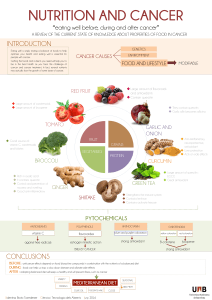

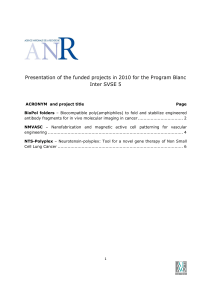
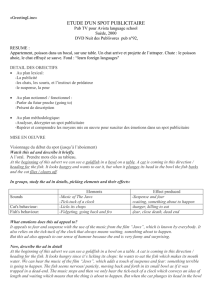

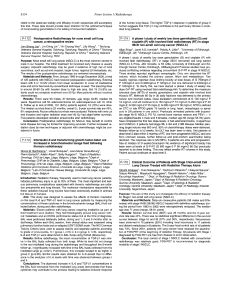
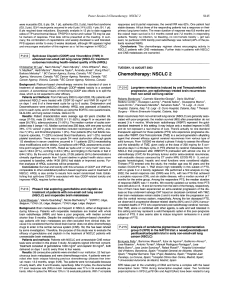


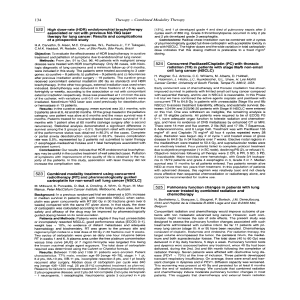


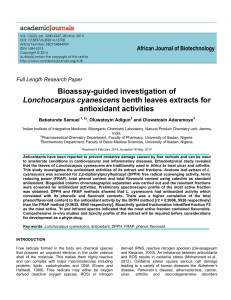
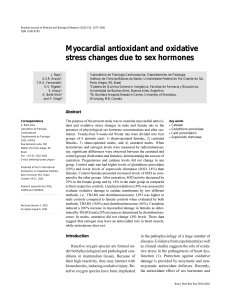
![Synthesis and antitumor evaluation of 8-phenylaminopyrimido[4,5-c]isoquinolinequinones](http://s1.studylibfr.com/store/data/008050748_1-17feee12f59ad69bcee9c544f11128db-300x300.png)
